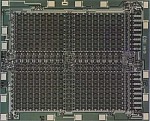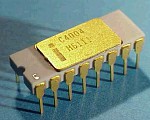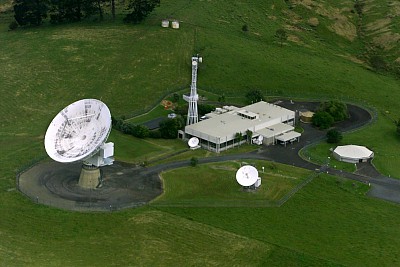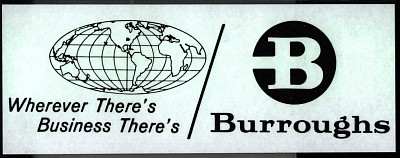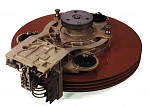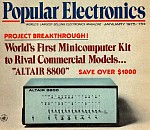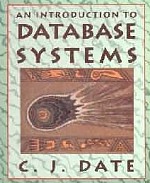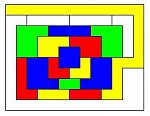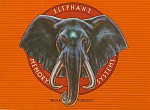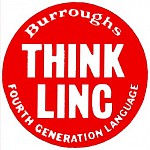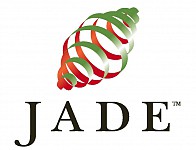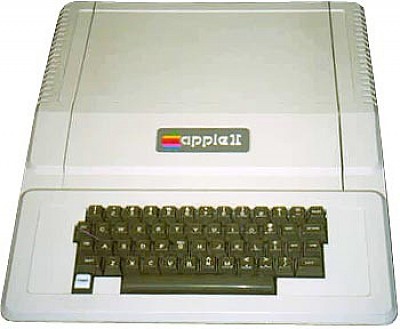Computer Science
Computing History Displays: Computer History Time Line - Onwards and upwards
Large computers, now called mainframes, steadily grow bigger and more powerful. Future technologies that will threaten the mainframe are under way.
The 1K RAM chip arrives with the IBM System/370 in 1970. It marks the first time that integrated circuit memory is used on a wide scale, and it ushers in an age of steady but dramatic development of the technology.
We will mark how the RAM chip size increases over the years, though without any images. The density of logic circuits tracks the memory improvement, but at a lower scale. This image is of an Intel 1003 RAM chip.
The first microprocessor chip, the Intel 4004, is unveiled in 1971. Initially intended to control an electronic wristwatch, it enables the development of the embedded controller. Today almost all complex devices, from automobiles to electronic zithers, contain one or more microprocessors. Further Images.
All New Zealand universities buy Burroughs B6700 computers in a bulk deal in 1972 and have full-scale mainframes for the first time. Most work is performed in the old punched-card batch manner, but remote access through telephone connections is provided for the first time. You can read more about the B6700 at our mainframe display on the 4th floor.
The IBM Winchester Disk, released in 1973, is the technology base from which the modern hard disk will be derived. Before the Winchester (model 3040) most databases have been held on removable disk packs. The 3040 is a removable disk but the removable module includes the reading mechanism and, because the device is sealed, it can accommodate much greater density of storage. In practice, the 3340 disks are not often dismounted; the fixed hard disk is born. You can read more about hard disks at our magnetic data storage display on the fifth floor.
In 1973 Computer Science departments are established at the University of Canterbury (Prof John Penny) and Massey University (Prof Graham Tate).
The Altair, a kitset, features on front page of Popular Mechanics magazine in December 1975. This is followed by other "do it yourself" computers in 1976. In the same year Microsoft Corporation is founded, its first product being a Basic compiler for Altair. We have a first generation IMSAI computer, compatible and competitive with the Altair, on display on our 3rd floor. Further Images.
4.3.9 An oracle's relations
E. F. (Ted) Codd (1923-2003), an English employee of IBM in San Jose, invents the concept of a Relational Data Base in the late 1960s, a systematic way of organising data stored in computer systems. His colleague C. J. Date publishes a series of books popularising the concept, including "Introduction to Data Base Systems" in 1975. Oracle Systems Corporation is foundedby Larry Ellison in 1977 to develop and market systems based on the Codd and Date ideas.
The invention of public key encryption in 1977 is a response to the need to provide security for private information sent between computers via public communication networks. Whitfield Diffie and Martin Helman propose an approach for encrypting messages which involves a public and private key. A practical version of this idea is the RSA algorithm of Rivest, Shamir and Adleman. Public key cryptography has since become a basic security tool for the internet, and it underlies digital signatures and electronic financial transactions.
4.3.13 Floppy disks
The floppy disk is developed by IBM to use for starting computers with volatile memories. The first floppies in 1972 are 8 inches in diameter. The floppy drives and disks were further developed and used in some of the first PCs, replacing punched cards for transporting data. But the release of the 5 1/4-inch in 1978 means the floppy becomes widespread. The 3 1/2-inch floppy from Sony will become standard in 1984. Floppy disks remain an important removable storage for PCs until the arrival of flash memory sticks - after the millenium (though there were many less satisfactory removable storage technologies tried in the interim). You can read more about floppy disks in our 5th floor display on magnetic data storage.
Two New Zealand computer programmers, Gilbert Simpson and Peter Hoskins, develop a "4th generation language" called LINC that simplifies application development. They create a company Aoraki Corporation based in Christchurch to further develop their products. LINC is adopted and marketed by Burroughs Corporation, later Unisys. Aoraki later becomes Jade Software Corporation. Sir Gil Simpson was knighted in 2000 for his service to the computer industry and broader community.
The first PCs, such as the Altair are intended for hobbyists who know details of electronics and software. From 1979, complete computers - the Apple 2, the Commodore and the TRS-80 - are provided that can be used without such detailed knowledge. Software products are developed that make computers worthwhile in business and entertaining in the home. Visicalc is the start of spreadsheets and there are many computer games - PACMAN for example. You can see many exampls of early PCs in our other displays, particularly on the 3rd floor. Further Images.
Top

